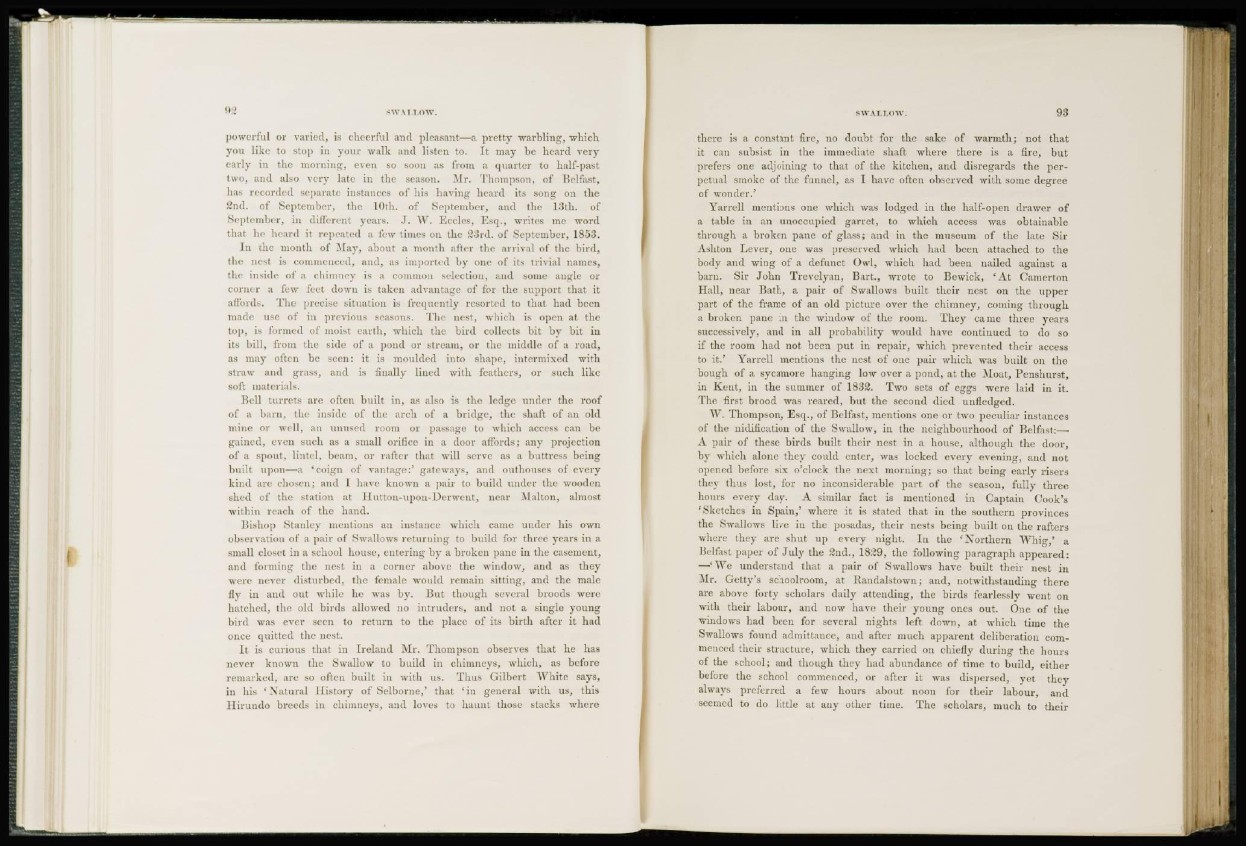
powerful or varied, is cheerful and pleasant—a pretty warbling, which
you like to stop in your walk and listen to. It may be heard very
early in the morning, even so soon as from a quarter to half-past
two, and also very late in the season. Mr. Thompson, of Belfast,
has recorded separate instances of his having heard its song on the
2nd. of September, the 10th. of September, and the 18th. of
September, in different years. J. W. Eccles, Esq., writes me word
that he heard it repeated a few times on the 23rd. of September, 1853.
In the month of May, about a month after the arrival of the bird,
the nest is commenced, and, as imported by one of its trivial names,
the inside of a chimney is a common selection, and some angle or
conn r a few feet down is taken advantage of for the support that it
affords. The precise situation is frequently resorted to that had been
made use of in previous seasons. The nest, which is open at the
top, is formed of moist earth, which the bird collects bit by bit in
its bill, from the side of a pond or stream, or the middle of a road,
as may often be seen: it is moulded into shape, intermixed with
straw and grass, and is finally lined with feathers, or such like
soft, materials.
Bell turrets are often built in, as also is the ledge under the roof
of a barn, the inside of the arch of a bridge, the shaft of an old
mine or well, an unused room or passage to which access can be
gained, even such as a small orifice in a door affords; any projection
of a spout, lintel, beam, or rafter that will serve as a buttress being
built upon—a 'coign of vantage:' gateways, and outhouses of every
kind are chosen; and I have known a pair to build under the wooden
shed of the station at Ifutton-upon-Derwcnt, near Malton, almost
within reach of the hand.
Bishop Stanley mentions an instance which came under his own
observation of a pair of Swrallows returning to build for three years in a
small closet in a school house, entering by a broken pane in the casement,
and forming the nest in a corner above the window, and as they
were never disturbed, the female would remain sitting, and the male
fly in and out while he was by. But though several broods were
hatched, the old birds allowed no intruders, and not a single young
bird was ever seen to return to the place of its birth after it had
once quitted the nest.
It is curious that in Ireland Mr. Thompson observes that he has
never known the Swallow to build in chimneys, which, as before
remarked, arc so often built in with us. Thus Gilbert White says,
in his 'Natural History of Selborne,' that 'in general with us, this
Hirundo breeds in chimneys, and loves to haunt those stacks where
there is a constant fire, no doubt for the sake of warmth; not that
it can subsist in the immediate shaft where there is a fire, but
prefers one adjoining to that of the kitchen, and disregards the perpetual
smoke of the funnel, as I have often observed with some degree
of wonder.'
Yai-rell mentions one which was lodged in the half-open drawer of
a table in an unoccupied garret, to which access was obtainable
through a broken pane of glass; and in the museum of the late Sir
Ashton Lever, one was preserved which had been attached to the
body and wing of a defunct Owl, which had been nailed against a
barn. Sir John Trevelyan, Bart., wrote to Bewick, 'At Camerton
Hall, near Bath, a pair of Swallows built their nest on the upper
part of the frame of an old picture over the chimney, coming through
a broken pane in the window of the room. They came three years
successively, and in all probability would have continued to do so
if the room had not been put in repair, which prevented their access
to it.' Yarrcll mentions the nest of one pair which was built on the
bough of a sycamore hanging low over a pond, at the Moat, Benshurst,
in Kent, in the summer of 1832. Two sets of eggs were laid in it.
The first brood was reared, but the second died unfledged.
W. Thompson, Esq., of Belfast, mentions one or two peculiar instances
of the nitUfication of the Swallow, in the neighbourhood of Belfast:—
A pair of these birds built their nest in a house, although the door,
bv which alone they could enter, was locked every evening, and not
opened before six o'clock the next morning; so that being early risers
they thus lost, for no inconsiderable part of the season, fully three
hours every day. A similar fact is mentioned in Captain Cook's
'Sketches in Spain,' where it is stated that in the southern provinces
the Swallows live in the posadas, their nests being built on the rafters
where they are shut up every night. In the ' Northern Whig,' a
Belfast paper of July the 2nd., 1829, the following paragraph appeared:
—' We understand that a pair of Swallows have built their nest in
Mr. Getty's schoolroom, at Randalstown; and, notwithstanding there
are above forty scholars daily attending, the birds fearlessly went on
with their labour, and now have their young ones out. One of the
windows had been for several nights left down, at which time the
Swallows found admittance, and after much apparent deliberation commenced
their structure, which they carried on chiefly during the hours
of the school; and though they had abundance of time to build, cither
before the school commenced, or after it was dispersed, yet they
always preferred a few hours about noon for their labour, and
seemed to do little at any other time. The scholars, much to their